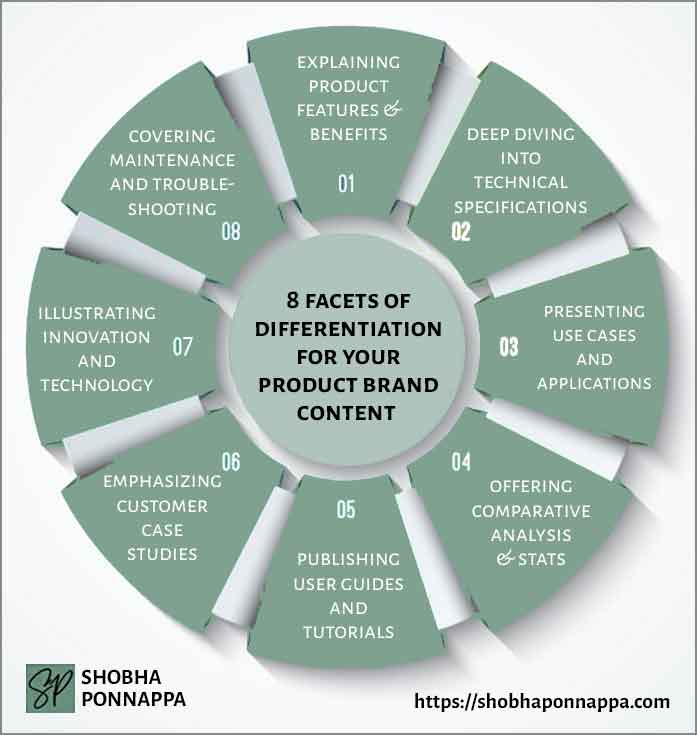
Let’s dive headfirst into the realm of unconventional content marketing strategies for product brands.
In a market arena teeming with predictability, this journey will unveil the critical elements of crafting captivating, strategically unique content to set your product brand apart from the crowd.
It’s high time to chart a different course for your product brand. You have to be ready for some offbeat thinking. Brace yourself to explore the depths of creativity, innovation, and the delightfully unexpected.
As we embark on a mission to revolutionize your content strategy, let’s see how we can make your brand genuinely remarkable. Be prepared to re-visit the world of product brand content marketing.
In today’s fiercely competitive market, product brands must rise above the ordinary and embrace uncommon content marketing to thrive. Commonplace strategies no longer suffice in capturing and retaining consumer attention.
Uncommon content marketing, on the other hand, provides the means to break through the clutter and establish a unique brand identity. For product brands, the need for uncommon content marketing is paramount.
It involves thinking beyond traditional advertising and diving into innovative storytelling that resonates with audiences on a deeper level. Uncommon content sparks curiosity, fosters engagement, and cultivates brand loyalty.
By the end of this exploration, you’ll understand how uncommon content marketing can help your product brand not only survive but thrive in a crowded marketplace, leaving a lasting impression on your audience.
Leveraging my expertise as a Brand Content Strategist with a penchant for the extraordinary, I unveil eight ingenious strategies to breathe life into your product brand’s content landscape. These unconventional approaches will take you far beyond the realms of traditional marketing, establishing the foundation for a truly distinctive online presence.
Prepare to dive headfirst into a world where conformity has no place, and innovation reigns supreme. Let’s embark on this journey to disrupt the status quo and elevate your product brand to unprecedented heights.

Explaining product features and benefits is at the core of creating unique and compelling content for your product brand. It’s not just about listing technical specifications; it’s about crafting a narrative that resonates with your audience.
Consider a hypothetical example: Imagine you’re marketing a state-of-the-art smartphone. Instead of merely stating its processor speed and camera resolution, delve into how these features enhance the user experience. Describe how the lightning-fast processor ensures seamless multitasking, while the high-resolution camera captures memories in stunning detail.
By elucidating these benefits, you’re not just selling a product; you’re selling an experience. Your audience can envision how this smartphone simplifies their daily tasks, captures beautiful moments, and enhances their overall lifestyle. This approach humanizes your product, making it relatable and desirable.
In your content marketing strategy, focus on elucidating not only what your product can do but also why it matters to your customers. Paint a vivid picture of the benefits they’ll enjoy, and you’ll forge a stronger connection with your audience.
Deep explaining of technical specifications is a vital component of crafting unique product brand content. It’s not just about throwing numbers and jargon at your audience; it’s about demystifying complexity and showcasing how technical aspects enhance the user experience.
Consider a hypothetical example: Imagine you’re marketing a high-end laptop. Instead of inundating readers with intricate details about the processor, RAM, and storage, delve into how these specifications translate into tangible benefits.
Explain how the powerful processor ensures lightning-fast performance, enabling seamless multitasking and quicker work completion. Highlight how ample RAM and storage capacity allows users to store and access their files effortlessly.
By presenting technical details in a user-centric manner, you’re providing potential buyers with valuable insights to make informed decisions. In today’s tech-savvy world, this approach fosters trust and empowers customers to understand the value your product offers, making your content both informative and persuasive.
Explaining use cases and applications is a pivotal aspect of crafting compelling product brand content. Instead of simply listing what a product does, this approach shows potential customers how it can fit seamlessly into their lives.
Consider a hypothetical example: Picture you’re marketing a smart home automation system. Rather than merely stating its capabilities, delve into practical scenarios. Explain how the system can streamline daily routines by automating tasks like adjusting lighting and temperature based on preferences.
Showcase how it enhances security by providing real-time alerts and remote monitoring. By painting a vivid picture of these use cases, you’re not just describing features – you’re demonstrating value.
This approach resonates with your audience on a personal level, allowing them to envision how your product can address their specific needs and desires. It’s a potent tool for connecting with potential customers and fostering a deeper understanding of your product’s potential.
Providing comparative analysis and statistics is a potent strategy in crafting distinctive product brand content. Instead of relying solely on self-promotion, this approach offers consumers valuable insights and data-driven comparisons.
Let’s consider a hypothetical example: Imagine you’re marketing a high-end digital camera. Instead of merely extolling its features, delve into a comparative analysis. Compare your camera’s performance, image quality, and user reviews against competitors in the same price range. Present statistics on aspects like shutter speed, resolution, and low-light capabilities.
By offering this data, you empower potential buyers to make informed decisions. They can see how your product stacks up against alternatives, backed by concrete evidence.
This approach builds trust and positions your brand as transparent and credible. In a world where consumers seek assurance in their purchases, providing a comparative analysis with stats can be a game-changer.
Creating user guides and tutorials is an indispensable element of crafting unique product brand content. These resources go beyond marketing; they empower users to maximize the value of your product.
Let’s consider a hypothetical example: Imagine you’re promoting a cutting-edge fitness tracker. Instead of solely emphasizing its features, offer comprehensive user guides. Develop tutorials on how to set up the tracker, sync it with smartphones, and interpret data. Include video demonstrations for exercises tailored to the tracker’s capabilities.
By providing these resources, you transform your brand into a valuable companion on the user’s fitness journey. Users not only purchase a product but gain a trusted resource for achieving their health goals.
This approach fosters loyalty, as customers feel supported and equipped to make the most of your product. In a world driven by convenience and self-improvement, user guides and tutorials are a powerful asset in your content arsenal.
Highlighting customer case studies is a strategic cornerstone of crafting exceptional product brand content. These real-life success stories breathe authenticity and credibility into your marketing efforts.
Let’s delve into a hypothetical example: Imagine you’re promoting a productivity software solution for businesses. Instead of solely touting its features, spotlight a customer case study. Share the journey of a small startup that transformed into a thriving company thanks to your software. Detail how they streamlined workflows, increased efficiency, and scaled operations.
By doing so, you’re not just selling a product; you’re illustrating the tangible benefits your solution offers. Customer case studies provide relatable narratives that resonate with potential buyers.
They can see themselves in the success of others, making your product’s value more tangible and trustworthy. In a competitive landscape, where trust is paramount, emphasizing customer case studies is a potent tool to sway prospects and elevate your brand’s reputation.
Showcasing innovation and technology within your product brand content is a dynamic strategy that captivates audiences. It goes beyond listing specifications; it’s about painting a vivid picture of how your product is pushing the boundaries of what’s possible.
Imagine you’re marketing a cutting-edge electric vehicle (EV). Rather than solely discussing its electric motor and battery capacity, illustrate its innovative regenerative braking system. Explain how this technology harnesses energy during braking, replenishing the battery and extending the driving range.
In this scenario, you’re not just promoting features; you’re narrating a story of environmental consciousness and efficiency. Highlighting innovation and technology not only underscores your product’s uniqueness but also positions your brand as a forward-thinking industry leader.
In a world driven by progress, customers seek products that offer more than just functionality – they want a glimpse into the future, and your content can provide that vision.
Addressing maintenance and troubleshooting in your product brand content is a strategic approach that nurtures customer trust and satisfaction. It’s not just about the initial sale; it’s about providing ongoing support and guidance.
Let’s consider a hypothetical example: Picture you’re marketing a high-end, smart home security system. Instead of merely showcasing its features, cover maintenance and troubleshooting. Offer step-by-step guides on how to perform routine system checks and updates, ensuring optimal performance. Moreover, provide clear instructions for troubleshooting common issues, such as connectivity problems or false alarms.
By doing so, you’re not just selling a product; you’re offering peace of mind. Customers know that they can rely on your brand not only for cutting-edge technology but also for ongoing support.
This approach builds loyalty and solidifies your brand as a trustworthy partner. In a world where convenience and reliability are paramount, covering maintenance and troubleshooting is a strategic move that resonates with customers.

"As a Content/Brand Specialist, and SEO/UX Writer, I can help transform your brand's online presence. I can lift it with innovative ideas to take it to an enviable position. Let's collaborate to create a captivating brand story, engage your audience, boost your online visibility, and increase your ROI. Take the next step towards your brand content success and contact me today."
Shobha Ponnappa
I Bring You:
Content Marketing That’s “Unusual By Strategy” … Tips, Tricks, Tactics, Techniques, Trends, Training.
Get my weekly ContenTracker Newsletter packed with loads of content marketing ideas – proven and unusual.
Get a free download of my ebook on “50 Unusual Ways To Use AI In Content Marketing” … and transform your success.

Just fill in the form to join my community … we have big and small brands for company. You’ll stay on the speedway to growth.
KEY TOPIC CATEGORIES COVERED ON THIS SITE:
COPYRIGHT © 2024. SHOBHAPONNAPPA.COM. ALL RIGHTS RESERVED.

Just fill in this form and get this awesome ebook in your email inbox. Plus … each week you’ll receive my ContenTracker Newsletter that brings you tips, tricks, tactics, techniques, trends, and training on the latest in content marketing.